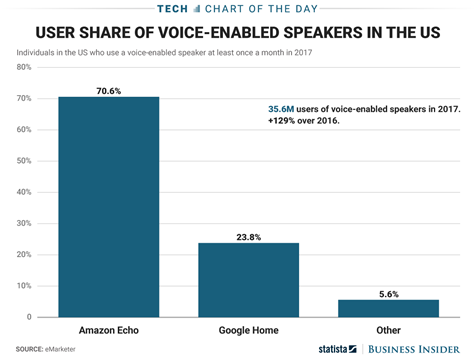The 2018 Consumer Electronics Show proved that voice isn’t going anywhere soon, in fact, it’s prominent in almost every industry. From automotive to healthcare, there has been significant growth in digital assistants. What’s possible now with voice is just the beginning of what will come in the following years and it shows great potential for developers everywhere.
Amazon’s Alexa is showing up in new and interesting integrations for major brands around the world. CES 2018 hosted a myriad of products and brands of smart speakers showing off an onslaught of Alexa integrations. The interest in developing tools for the platform has skyrocketed as many developers show eagerness to jump into the rapidly growing ecosystem.
The Smart Speaker Landscape
The Consumer Technology Association (CTA), which is the organization that runs CES, reports that sales of smart speakers rose by 279% last year while eMarketer predicts that voice-enabled speaker usage will grow nearly 130% in 2018.
Amazon has a number of device types in the market including the echo and Echo Dot, Echo Plus, Echo Show and Echo Spot, Echo Look, and third-party applications. Google coincidingly launched the Google Home and their Voice Assistant which was released on the Pixel phone.
Recommended Reading: 7 Mobile App Development Trends That Will Get Bigger In 2018
However, while other companies were focusing on AR and VR, Amazon was working on Alexa Skills. The adoption of Amazon’s Alexa through the Echo devices and third-party developers far exceeded expectations. Now, Alexa is leading the competition, dominating over 70% of the smart speaker market.
But Amazon isn’t the only major player now. Apple, Google, Windows, and Samsung are following behind and some brands are now looking at building their own personalities, from bots to voice assistants, like Domino’s pizza-ordering AI personality, Dom. Some others include Campbell Soup Company, Uber, and Capital One that are building apps (“skills” for Alexa, “actions” for Google) that allow users to search for recipes, order a ride, and check bank balances by speaking to a voice-enabled device.
When iPhone was first released, there was a surge in app development as developers and brands rushed to get mobile apps out. Now we’re experiencing that same urgency as voice is the new frontier of mobile apps. In fact, Gartner estimates that there will be more than 20 billion voice-enabled appliances, TVs, and other IoT devices by 2020.
Consumers are expecting unique and personalized experiences. Brands aren’t only focusing on getting information to users wherever they are, but more so focusing on an immersive experience.
Alexa Paving The Way
Amazon’s expansion of Alexa’s capabilities beyond its own devices continues to move at shocking speeds. Just a few weeks ago, we saw an expansion of Alexa Skills in computers, cars, mirrors, and even toilets. There has even been further speculation that Alexa is coming to the healthcare sector.
Amazon is making sure they are staying well ahead of voice competition by controlling key functions through mobile phones as some virtual assistants are still finding their way in the market.
A New Interface For Users
Alexa has helped to drive interest in the use of voice technology. Other services such as Apple Siri, Google Now, and Microsoft Cortana launched before Alexa, however, it is Amazon that has become synonymous with voice assistants, stealing the show from Siri.
Recommended Reading: Microsoft Azure: How to Build Smart Apps Using Cognitive Services
The rising popularity of Alexa is changing the way we build user interfaces. Alexa allows users to access information and services through hands-free operation. Voice provides an entirely new way of interacting with technology that will transform the way users interact with mobile apps altogether.
Source: Samsung
A Learning Opportunity For Brands
With voice services, brands are getting a better understanding of what their users want as this technology provides insight into customers’ behavioral patterns and preferences inside their own home. They can identify what information a customer is searching for when using a particular skill, how much time users spend interacting with a skill, and so on.
Should You Include Voice In Your Mobile Strategy?
Developers are experimenting with this new technology and looking for opportunities for voice interaction, however, you need to be cognizant when adopting any new technology. Does it make sense for your brand? Look for opportunities where your customers are wanting to interact with your brand, but make sure to keep it simple or else you’ll end up frustrating your users. It’s important to note that just because AI and voice-enabled devices are growing in popularity as more brands are adopting, it may not make sense for your brand. When considering working with voice services, ask how it will drive real value.
Closing Thoughts
Now that Amazon, Google, and many other colossal brands have proven the value of voice, we will see continuous growth in this space. Between cars, home appliances, and so on, the opportunities for voice integration are endless. Companies are now realizing that voice provides consumers with the ability to connect directly and more conveniently with the content they want. The number of Alexa integrations announced during CES proved Amazon’s dominance with this emerging technology and demonstrated the potential that Alexa and voice services have to transform interactions between brands and their users.







